Boeing Company's Operational Management: Facets, Objectives Analysis
VerifiedAdded on 2023/04/19
|27
|7563
|95
Report
AI Summary
This report provides an in-depth analysis of the operational management of the Boeing Company, focusing on five key facets: layout and flow, inventory management, supply chain management, lean operations, and quality management. It explores the theoretical foundations of these facets and evaluates their impact on operational objectives such as cost, quality, speed, dependability, and flexibility. The report also examines how Boeing utilizes a hybrid layout in its manufacturing process and discusses the advantages and challenges associated with it. Furthermore, it delves into Boeing's quality management strategies, highlighting the importance of maintaining high standards in the aircraft industry. The analysis includes critical evaluation of the impact of quality management on operational objectives like cost and safety. Finally, the report suggests operational management concepts that Boeing can implement to improve business performance based on the five operational objectives.

Running head: OPERATION
Operation
Name of the Student
Name of the University
Author Note
Operation
Name of the Student
Name of the University
Author Note
Paraphrase This Document
Need a fresh take? Get an instant paraphrase of this document with our AI Paraphraser
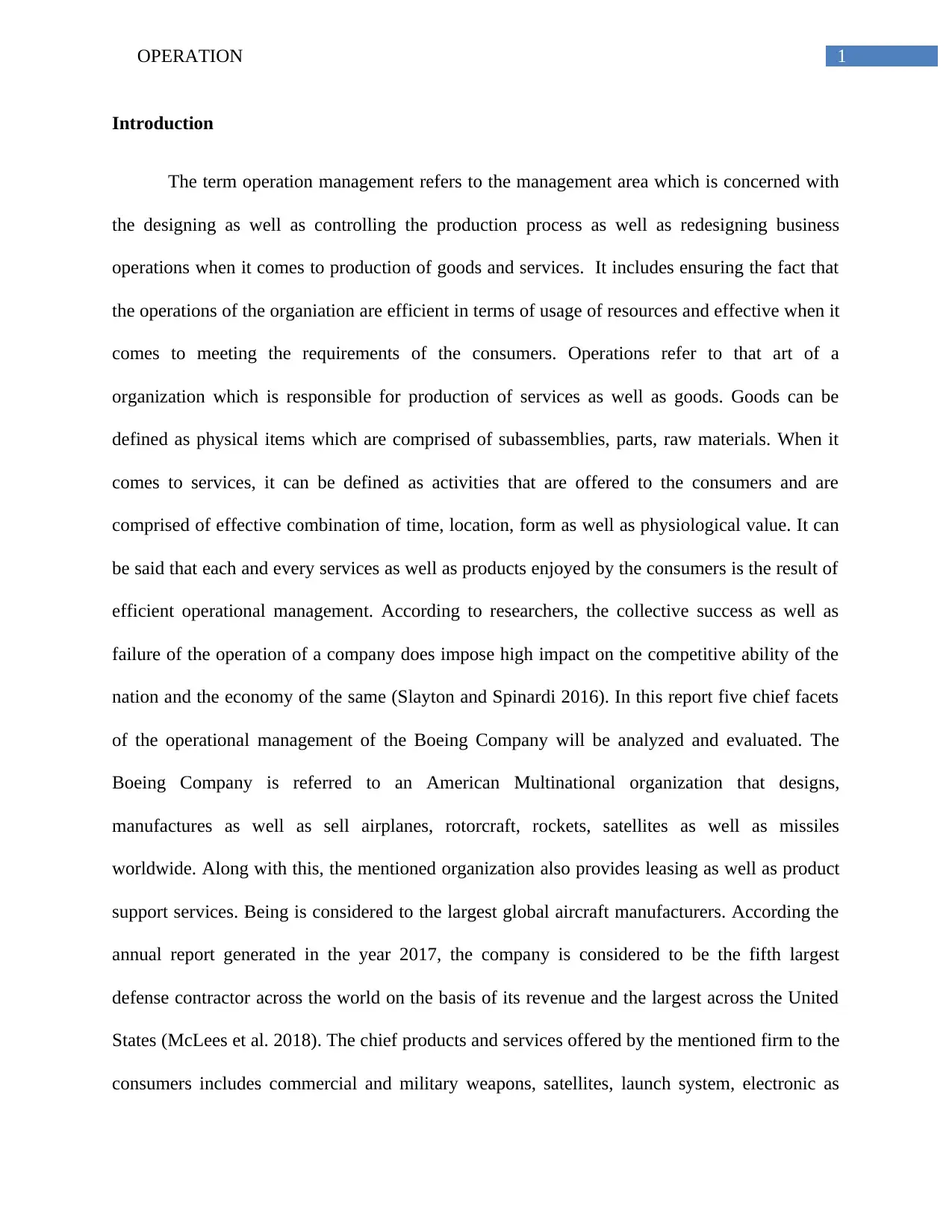
1OPERATION
Introduction
The term operation management refers to the management area which is concerned with
the designing as well as controlling the production process as well as redesigning business
operations when it comes to production of goods and services. It includes ensuring the fact that
the operations of the organiation are efficient in terms of usage of resources and effective when it
comes to meeting the requirements of the consumers. Operations refer to that art of a
organization which is responsible for production of services as well as goods. Goods can be
defined as physical items which are comprised of subassemblies, parts, raw materials. When it
comes to services, it can be defined as activities that are offered to the consumers and are
comprised of effective combination of time, location, form as well as physiological value. It can
be said that each and every services as well as products enjoyed by the consumers is the result of
efficient operational management. According to researchers, the collective success as well as
failure of the operation of a company does impose high impact on the competitive ability of the
nation and the economy of the same (Slayton and Spinardi 2016). In this report five chief facets
of the operational management of the Boeing Company will be analyzed and evaluated. The
Boeing Company is referred to an American Multinational organization that designs,
manufactures as well as sell airplanes, rotorcraft, rockets, satellites as well as missiles
worldwide. Along with this, the mentioned organization also provides leasing as well as product
support services. Being is considered to the largest global aircraft manufacturers. According the
annual report generated in the year 2017, the company is considered to be the fifth largest
defense contractor across the world on the basis of its revenue and the largest across the United
States (McLees et al. 2018). The chief products and services offered by the mentioned firm to the
consumers includes commercial and military weapons, satellites, launch system, electronic as
Introduction
The term operation management refers to the management area which is concerned with
the designing as well as controlling the production process as well as redesigning business
operations when it comes to production of goods and services. It includes ensuring the fact that
the operations of the organiation are efficient in terms of usage of resources and effective when it
comes to meeting the requirements of the consumers. Operations refer to that art of a
organization which is responsible for production of services as well as goods. Goods can be
defined as physical items which are comprised of subassemblies, parts, raw materials. When it
comes to services, it can be defined as activities that are offered to the consumers and are
comprised of effective combination of time, location, form as well as physiological value. It can
be said that each and every services as well as products enjoyed by the consumers is the result of
efficient operational management. According to researchers, the collective success as well as
failure of the operation of a company does impose high impact on the competitive ability of the
nation and the economy of the same (Slayton and Spinardi 2016). In this report five chief facets
of the operational management of the Boeing Company will be analyzed and evaluated. The
Boeing Company is referred to an American Multinational organization that designs,
manufactures as well as sell airplanes, rotorcraft, rockets, satellites as well as missiles
worldwide. Along with this, the mentioned organization also provides leasing as well as product
support services. Being is considered to the largest global aircraft manufacturers. According the
annual report generated in the year 2017, the company is considered to be the fifth largest
defense contractor across the world on the basis of its revenue and the largest across the United
States (McLees et al. 2018). The chief products and services offered by the mentioned firm to the
consumers includes commercial and military weapons, satellites, launch system, electronic as
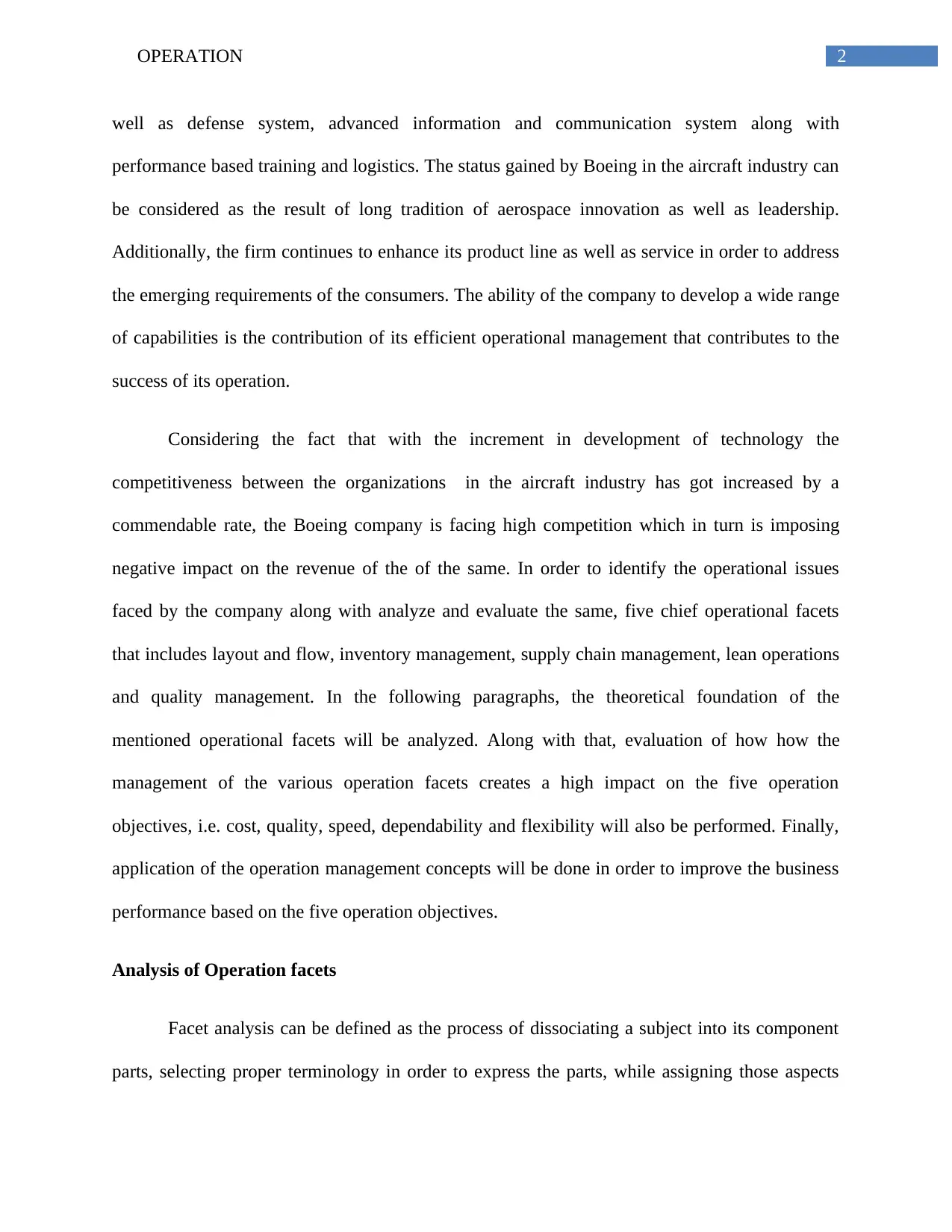
2OPERATION
well as defense system, advanced information and communication system along with
performance based training and logistics. The status gained by Boeing in the aircraft industry can
be considered as the result of long tradition of aerospace innovation as well as leadership.
Additionally, the firm continues to enhance its product line as well as service in order to address
the emerging requirements of the consumers. The ability of the company to develop a wide range
of capabilities is the contribution of its efficient operational management that contributes to the
success of its operation.
Considering the fact that with the increment in development of technology the
competitiveness between the organizations in the aircraft industry has got increased by a
commendable rate, the Boeing company is facing high competition which in turn is imposing
negative impact on the revenue of the of the same. In order to identify the operational issues
faced by the company along with analyze and evaluate the same, five chief operational facets
that includes layout and flow, inventory management, supply chain management, lean operations
and quality management. In the following paragraphs, the theoretical foundation of the
mentioned operational facets will be analyzed. Along with that, evaluation of how how the
management of the various operation facets creates a high impact on the five operation
objectives, i.e. cost, quality, speed, dependability and flexibility will also be performed. Finally,
application of the operation management concepts will be done in order to improve the business
performance based on the five operation objectives.
Analysis of Operation facets
Facet analysis can be defined as the process of dissociating a subject into its component
parts, selecting proper terminology in order to express the parts, while assigning those aspects
well as defense system, advanced information and communication system along with
performance based training and logistics. The status gained by Boeing in the aircraft industry can
be considered as the result of long tradition of aerospace innovation as well as leadership.
Additionally, the firm continues to enhance its product line as well as service in order to address
the emerging requirements of the consumers. The ability of the company to develop a wide range
of capabilities is the contribution of its efficient operational management that contributes to the
success of its operation.
Considering the fact that with the increment in development of technology the
competitiveness between the organizations in the aircraft industry has got increased by a
commendable rate, the Boeing company is facing high competition which in turn is imposing
negative impact on the revenue of the of the same. In order to identify the operational issues
faced by the company along with analyze and evaluate the same, five chief operational facets
that includes layout and flow, inventory management, supply chain management, lean operations
and quality management. In the following paragraphs, the theoretical foundation of the
mentioned operational facets will be analyzed. Along with that, evaluation of how how the
management of the various operation facets creates a high impact on the five operation
objectives, i.e. cost, quality, speed, dependability and flexibility will also be performed. Finally,
application of the operation management concepts will be done in order to improve the business
performance based on the five operation objectives.
Analysis of Operation facets
Facet analysis can be defined as the process of dissociating a subject into its component
parts, selecting proper terminology in order to express the parts, while assigning those aspects
⊘ This is a preview!⊘
Do you want full access?
Subscribe today to unlock all pages.

Trusted by 1+ million students worldwide
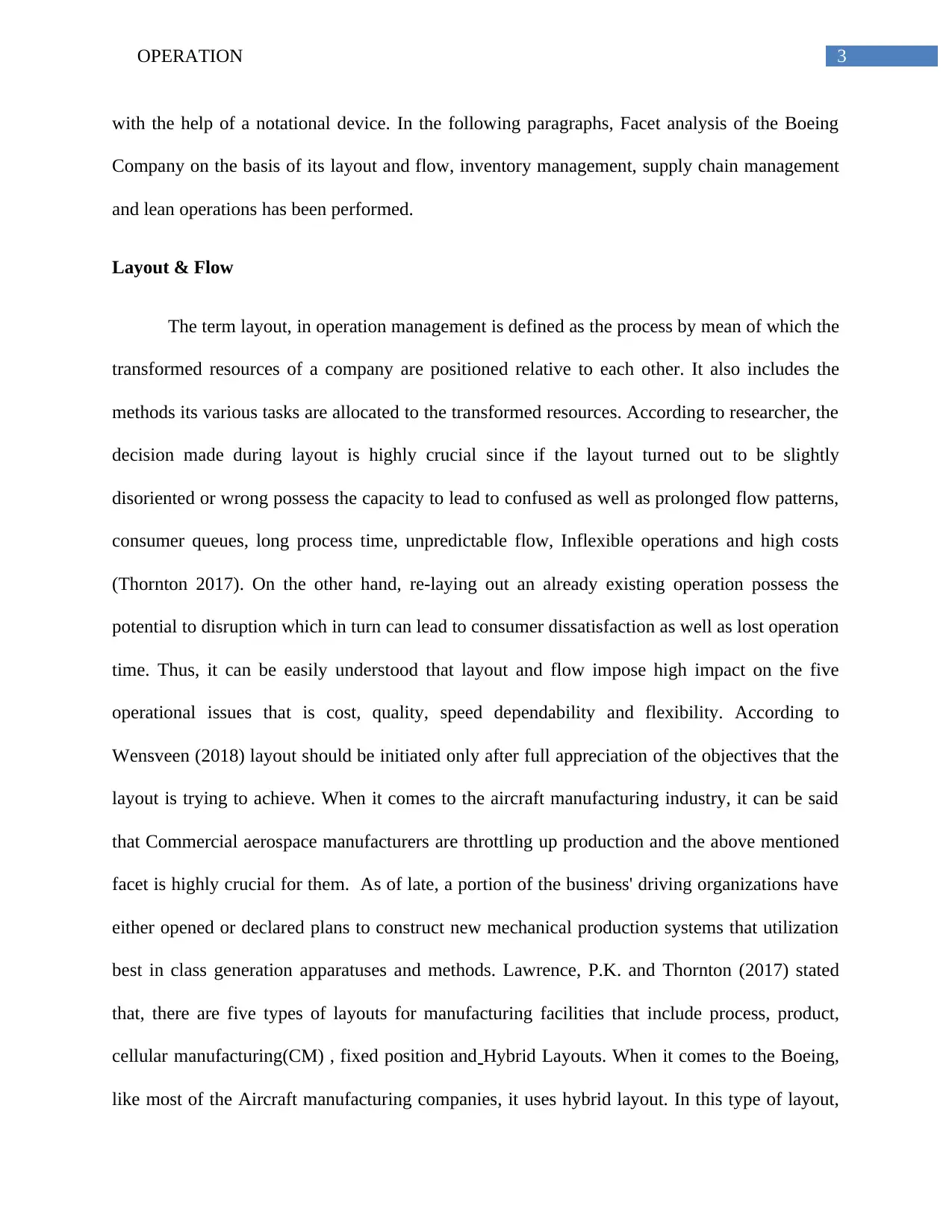
3OPERATION
with the help of a notational device. In the following paragraphs, Facet analysis of the Boeing
Company on the basis of its layout and flow, inventory management, supply chain management
and lean operations has been performed.
Layout & Flow
The term layout, in operation management is defined as the process by mean of which the
transformed resources of a company are positioned relative to each other. It also includes the
methods its various tasks are allocated to the transformed resources. According to researcher, the
decision made during layout is highly crucial since if the layout turned out to be slightly
disoriented or wrong possess the capacity to lead to confused as well as prolonged flow patterns,
consumer queues, long process time, unpredictable flow, Inflexible operations and high costs
(Thornton 2017). On the other hand, re-laying out an already existing operation possess the
potential to disruption which in turn can lead to consumer dissatisfaction as well as lost operation
time. Thus, it can be easily understood that layout and flow impose high impact on the five
operational issues that is cost, quality, speed dependability and flexibility. According to
Wensveen (2018) layout should be initiated only after full appreciation of the objectives that the
layout is trying to achieve. When it comes to the aircraft manufacturing industry, it can be said
that Commercial aerospace manufacturers are throttling up production and the above mentioned
facet is highly crucial for them. As of late, a portion of the business' driving organizations have
either opened or declared plans to construct new mechanical production systems that utilization
best in class generation apparatuses and methods. Lawrence, P.K. and Thornton (2017) stated
that, there are five types of layouts for manufacturing facilities that include process, product,
cellular manufacturing(CM) , fixed position and Hybrid Layouts. When it comes to the Boeing,
like most of the Aircraft manufacturing companies, it uses hybrid layout. In this type of layout,
with the help of a notational device. In the following paragraphs, Facet analysis of the Boeing
Company on the basis of its layout and flow, inventory management, supply chain management
and lean operations has been performed.
Layout & Flow
The term layout, in operation management is defined as the process by mean of which the
transformed resources of a company are positioned relative to each other. It also includes the
methods its various tasks are allocated to the transformed resources. According to researcher, the
decision made during layout is highly crucial since if the layout turned out to be slightly
disoriented or wrong possess the capacity to lead to confused as well as prolonged flow patterns,
consumer queues, long process time, unpredictable flow, Inflexible operations and high costs
(Thornton 2017). On the other hand, re-laying out an already existing operation possess the
potential to disruption which in turn can lead to consumer dissatisfaction as well as lost operation
time. Thus, it can be easily understood that layout and flow impose high impact on the five
operational issues that is cost, quality, speed dependability and flexibility. According to
Wensveen (2018) layout should be initiated only after full appreciation of the objectives that the
layout is trying to achieve. When it comes to the aircraft manufacturing industry, it can be said
that Commercial aerospace manufacturers are throttling up production and the above mentioned
facet is highly crucial for them. As of late, a portion of the business' driving organizations have
either opened or declared plans to construct new mechanical production systems that utilization
best in class generation apparatuses and methods. Lawrence, P.K. and Thornton (2017) stated
that, there are five types of layouts for manufacturing facilities that include process, product,
cellular manufacturing(CM) , fixed position and Hybrid Layouts. When it comes to the Boeing,
like most of the Aircraft manufacturing companies, it uses hybrid layout. In this type of layout,
Paraphrase This Document
Need a fresh take? Get an instant paraphrase of this document with our AI Paraphraser
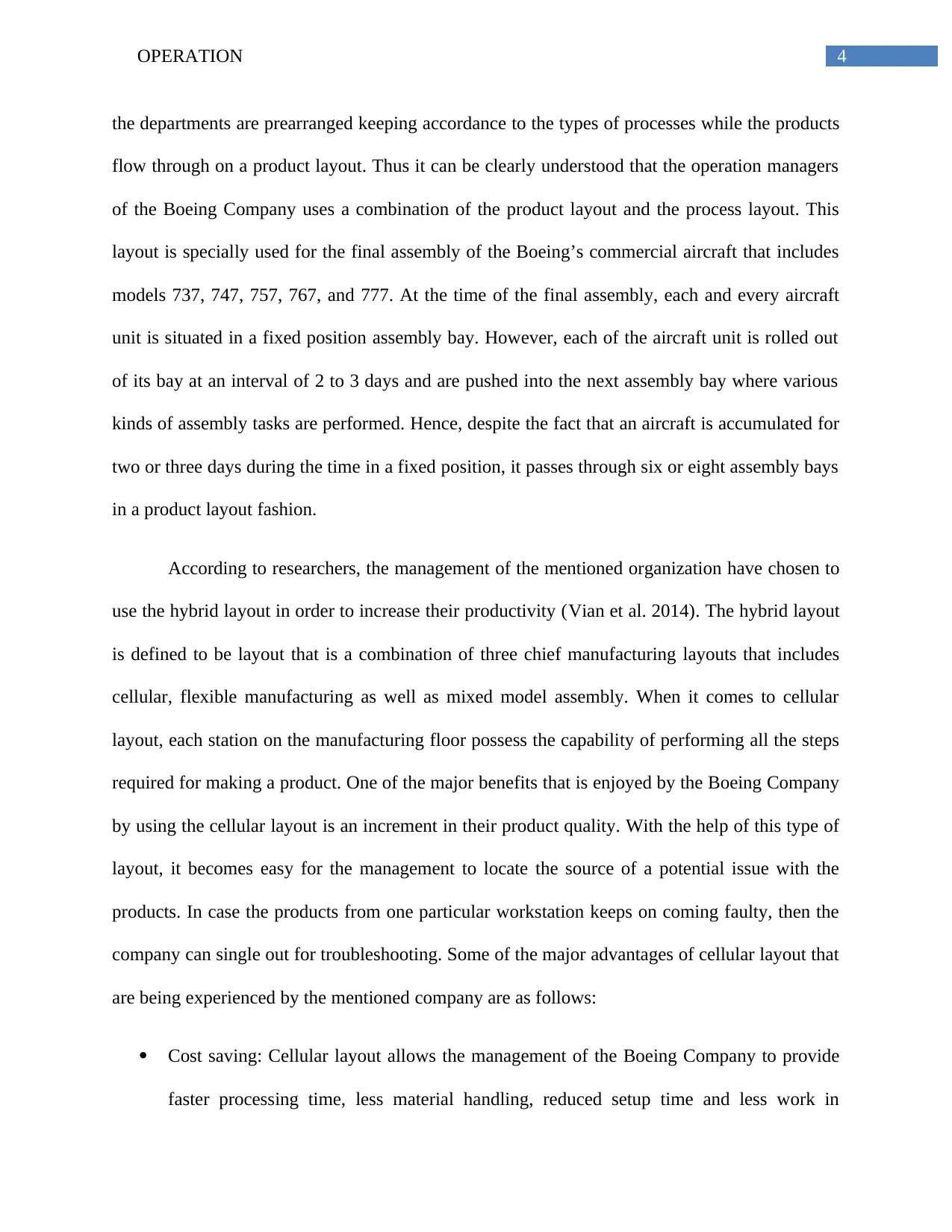
4OPERATION
the departments are prearranged keeping accordance to the types of processes while the products
flow through on a product layout. Thus it can be clearly understood that the operation managers
of the Boeing Company uses a combination of the product layout and the process layout. This
layout is specially used for the final assembly of the Boeing’s commercial aircraft that includes
models 737, 747, 757, 767, and 777. At the time of the final assembly, each and every aircraft
unit is situated in a fixed position assembly bay. However, each of the aircraft unit is rolled out
of its bay at an interval of 2 to 3 days and are pushed into the next assembly bay where various
kinds of assembly tasks are performed. Hence, despite the fact that an aircraft is accumulated for
two or three days during the time in a fixed position, it passes through six or eight assembly bays
in a product layout fashion.
According to researchers, the management of the mentioned organization have chosen to
use the hybrid layout in order to increase their productivity (Vian et al. 2014). The hybrid layout
is defined to be layout that is a combination of three chief manufacturing layouts that includes
cellular, flexible manufacturing as well as mixed model assembly. When it comes to cellular
layout, each station on the manufacturing floor possess the capability of performing all the steps
required for making a product. One of the major benefits that is enjoyed by the Boeing Company
by using the cellular layout is an increment in their product quality. With the help of this type of
layout, it becomes easy for the management to locate the source of a potential issue with the
products. In case the products from one particular workstation keeps on coming faulty, then the
company can single out for troubleshooting. Some of the major advantages of cellular layout that
are being experienced by the mentioned company are as follows:
Cost saving: Cellular layout allows the management of the Boeing Company to provide
faster processing time, less material handling, reduced setup time and less work in
the departments are prearranged keeping accordance to the types of processes while the products
flow through on a product layout. Thus it can be clearly understood that the operation managers
of the Boeing Company uses a combination of the product layout and the process layout. This
layout is specially used for the final assembly of the Boeing’s commercial aircraft that includes
models 737, 747, 757, 767, and 777. At the time of the final assembly, each and every aircraft
unit is situated in a fixed position assembly bay. However, each of the aircraft unit is rolled out
of its bay at an interval of 2 to 3 days and are pushed into the next assembly bay where various
kinds of assembly tasks are performed. Hence, despite the fact that an aircraft is accumulated for
two or three days during the time in a fixed position, it passes through six or eight assembly bays
in a product layout fashion.
According to researchers, the management of the mentioned organization have chosen to
use the hybrid layout in order to increase their productivity (Vian et al. 2014). The hybrid layout
is defined to be layout that is a combination of three chief manufacturing layouts that includes
cellular, flexible manufacturing as well as mixed model assembly. When it comes to cellular
layout, each station on the manufacturing floor possess the capability of performing all the steps
required for making a product. One of the major benefits that is enjoyed by the Boeing Company
by using the cellular layout is an increment in their product quality. With the help of this type of
layout, it becomes easy for the management to locate the source of a potential issue with the
products. In case the products from one particular workstation keeps on coming faulty, then the
company can single out for troubleshooting. Some of the major advantages of cellular layout that
are being experienced by the mentioned company are as follows:
Cost saving: Cellular layout allows the management of the Boeing Company to provide
faster processing time, less material handling, reduced setup time and less work in
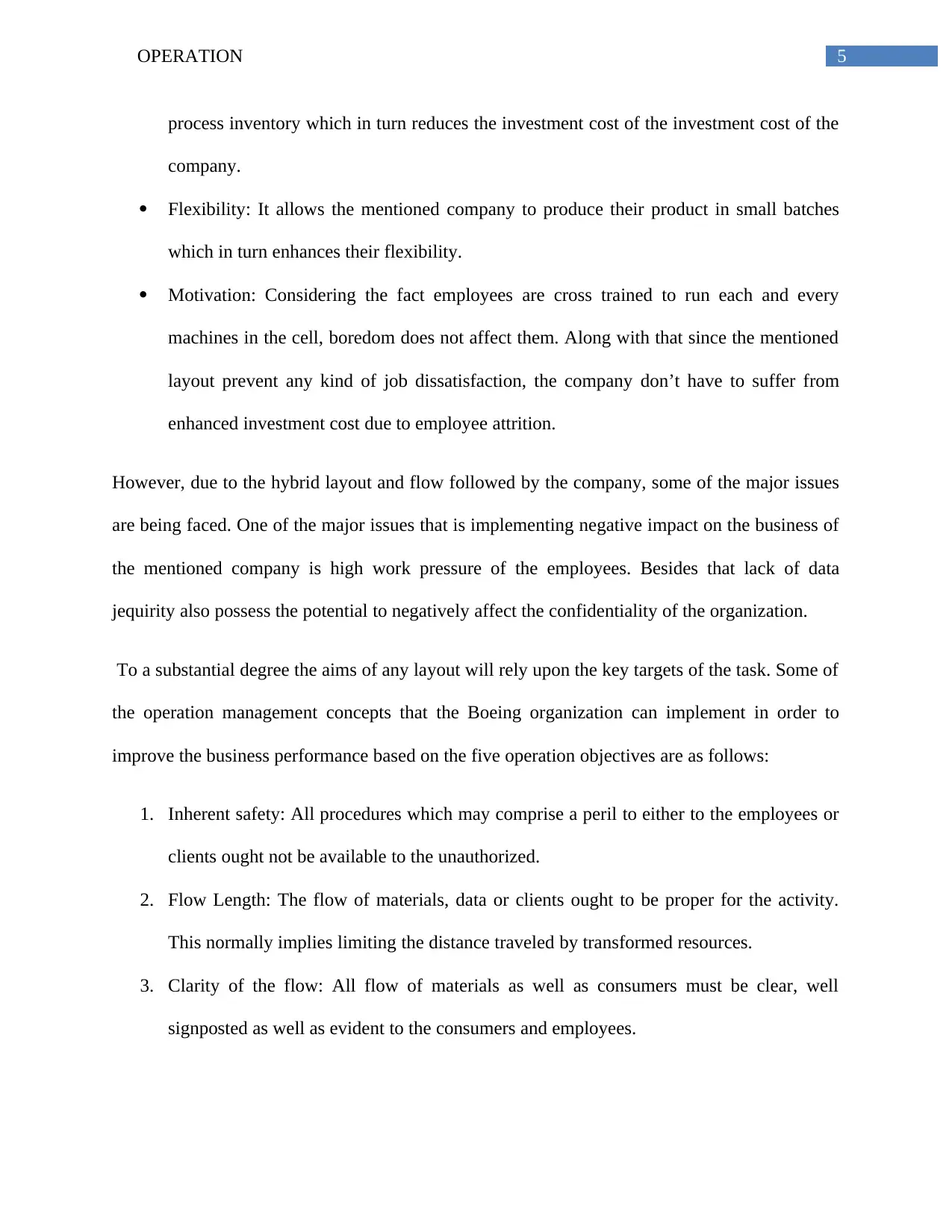
5OPERATION
process inventory which in turn reduces the investment cost of the investment cost of the
company.
Flexibility: It allows the mentioned company to produce their product in small batches
which in turn enhances their flexibility.
Motivation: Considering the fact employees are cross trained to run each and every
machines in the cell, boredom does not affect them. Along with that since the mentioned
layout prevent any kind of job dissatisfaction, the company don’t have to suffer from
enhanced investment cost due to employee attrition.
However, due to the hybrid layout and flow followed by the company, some of the major issues
are being faced. One of the major issues that is implementing negative impact on the business of
the mentioned company is high work pressure of the employees. Besides that lack of data
jequirity also possess the potential to negatively affect the confidentiality of the organization.
To a substantial degree the aims of any layout will rely upon the key targets of the task. Some of
the operation management concepts that the Boeing organization can implement in order to
improve the business performance based on the five operation objectives are as follows:
1. Inherent safety: All procedures which may comprise a peril to either to the employees or
clients ought not be available to the unauthorized.
2. Flow Length: The flow of materials, data or clients ought to be proper for the activity.
This normally implies limiting the distance traveled by transformed resources.
3. Clarity of the flow: All flow of materials as well as consumers must be clear, well
signposted as well as evident to the consumers and employees.
process inventory which in turn reduces the investment cost of the investment cost of the
company.
Flexibility: It allows the mentioned company to produce their product in small batches
which in turn enhances their flexibility.
Motivation: Considering the fact employees are cross trained to run each and every
machines in the cell, boredom does not affect them. Along with that since the mentioned
layout prevent any kind of job dissatisfaction, the company don’t have to suffer from
enhanced investment cost due to employee attrition.
However, due to the hybrid layout and flow followed by the company, some of the major issues
are being faced. One of the major issues that is implementing negative impact on the business of
the mentioned company is high work pressure of the employees. Besides that lack of data
jequirity also possess the potential to negatively affect the confidentiality of the organization.
To a substantial degree the aims of any layout will rely upon the key targets of the task. Some of
the operation management concepts that the Boeing organization can implement in order to
improve the business performance based on the five operation objectives are as follows:
1. Inherent safety: All procedures which may comprise a peril to either to the employees or
clients ought not be available to the unauthorized.
2. Flow Length: The flow of materials, data or clients ought to be proper for the activity.
This normally implies limiting the distance traveled by transformed resources.
3. Clarity of the flow: All flow of materials as well as consumers must be clear, well
signposted as well as evident to the consumers and employees.
⊘ This is a preview!⊘
Do you want full access?
Subscribe today to unlock all pages.

Trusted by 1+ million students worldwide
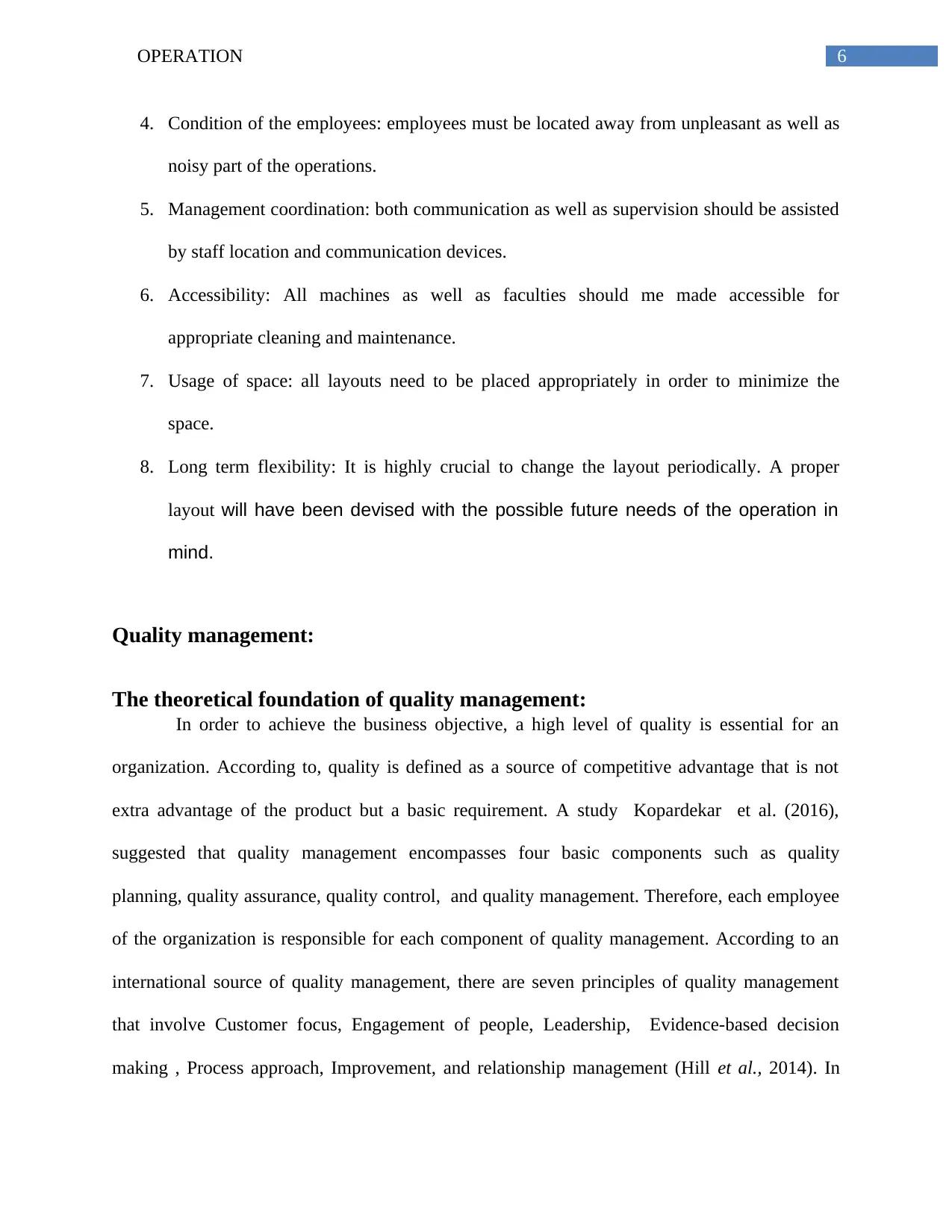
6OPERATION
4. Condition of the employees: employees must be located away from unpleasant as well as
noisy part of the operations.
5. Management coordination: both communication as well as supervision should be assisted
by staff location and communication devices.
6. Accessibility: All machines as well as faculties should me made accessible for
appropriate cleaning and maintenance.
7. Usage of space: all layouts need to be placed appropriately in order to minimize the
space.
8. Long term flexibility: It is highly crucial to change the layout periodically. A proper
layout will have been devised with the possible future needs of the operation in
mind.
Quality management:
The theoretical foundation of quality management:
In order to achieve the business objective, a high level of quality is essential for an
organization. According to, quality is defined as a source of competitive advantage that is not
extra advantage of the product but a basic requirement. A study Kopardekar et al. (2016),
suggested that quality management encompasses four basic components such as quality
planning, quality assurance, quality control, and quality management. Therefore, each employee
of the organization is responsible for each component of quality management. According to an
international source of quality management, there are seven principles of quality management
that involve Customer focus, Engagement of people, Leadership, Evidence-based decision
making , Process approach, Improvement, and relationship management (Hill et al., 2014). In
4. Condition of the employees: employees must be located away from unpleasant as well as
noisy part of the operations.
5. Management coordination: both communication as well as supervision should be assisted
by staff location and communication devices.
6. Accessibility: All machines as well as faculties should me made accessible for
appropriate cleaning and maintenance.
7. Usage of space: all layouts need to be placed appropriately in order to minimize the
space.
8. Long term flexibility: It is highly crucial to change the layout periodically. A proper
layout will have been devised with the possible future needs of the operation in
mind.
Quality management:
The theoretical foundation of quality management:
In order to achieve the business objective, a high level of quality is essential for an
organization. According to, quality is defined as a source of competitive advantage that is not
extra advantage of the product but a basic requirement. A study Kopardekar et al. (2016),
suggested that quality management encompasses four basic components such as quality
planning, quality assurance, quality control, and quality management. Therefore, each employee
of the organization is responsible for each component of quality management. According to an
international source of quality management, there are seven principles of quality management
that involve Customer focus, Engagement of people, Leadership, Evidence-based decision
making , Process approach, Improvement, and relationship management (Hill et al., 2014). In
Paraphrase This Document
Need a fresh take? Get an instant paraphrase of this document with our AI Paraphraser
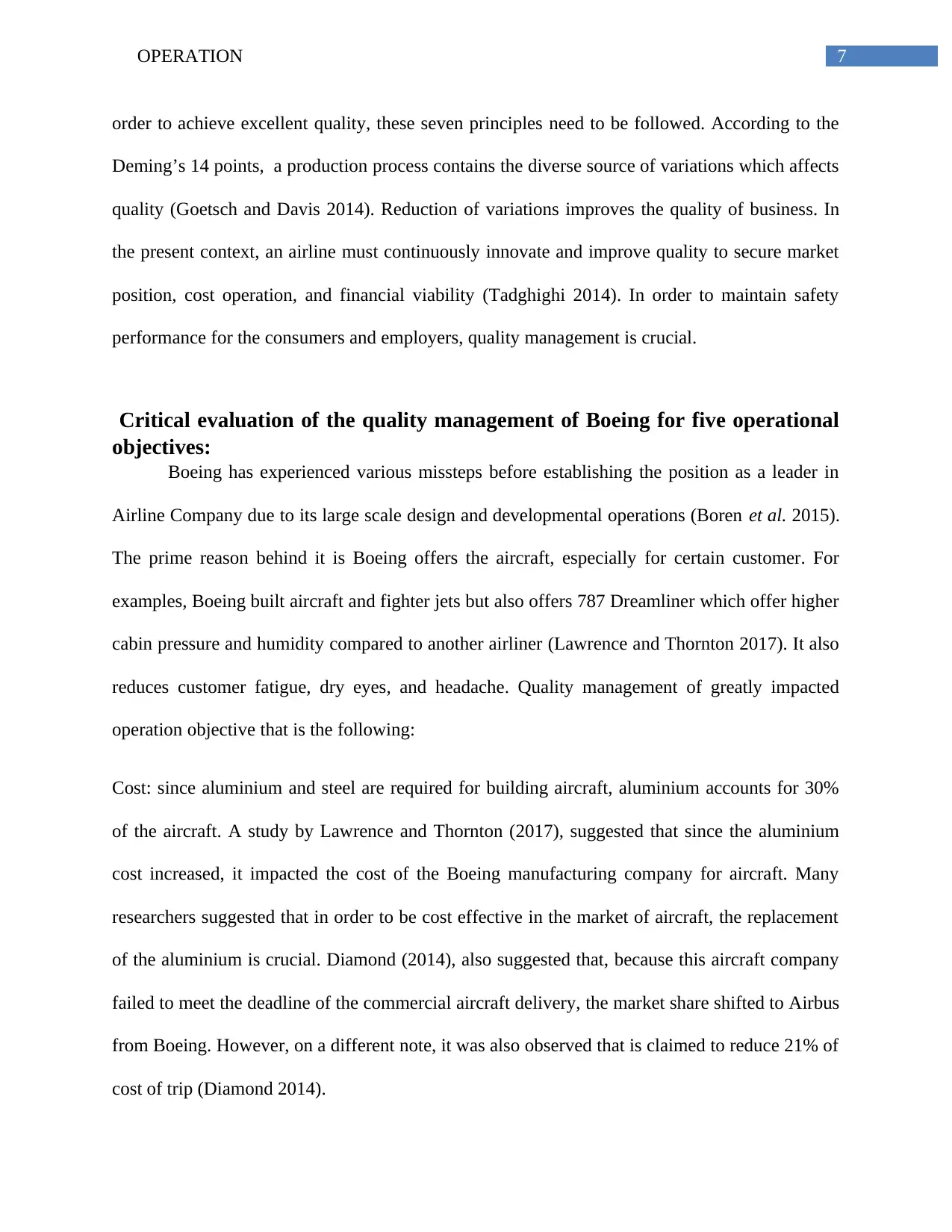
7OPERATION
order to achieve excellent quality, these seven principles need to be followed. According to the
Deming’s 14 points, a production process contains the diverse source of variations which affects
quality (Goetsch and Davis 2014). Reduction of variations improves the quality of business. In
the present context, an airline must continuously innovate and improve quality to secure market
position, cost operation, and financial viability (Tadghighi 2014). In order to maintain safety
performance for the consumers and employers, quality management is crucial.
Critical evaluation of the quality management of Boeing for five operational
objectives:
Boeing has experienced various missteps before establishing the position as a leader in
Airline Company due to its large scale design and developmental operations (Boren et al. 2015).
The prime reason behind it is Boeing offers the aircraft, especially for certain customer. For
examples, Boeing built aircraft and fighter jets but also offers 787 Dreamliner which offer higher
cabin pressure and humidity compared to another airliner (Lawrence and Thornton 2017). It also
reduces customer fatigue, dry eyes, and headache. Quality management of greatly impacted
operation objective that is the following:
Cost: since aluminium and steel are required for building aircraft, aluminium accounts for 30%
of the aircraft. A study by Lawrence and Thornton (2017), suggested that since the aluminium
cost increased, it impacted the cost of the Boeing manufacturing company for aircraft. Many
researchers suggested that in order to be cost effective in the market of aircraft, the replacement
of the aluminium is crucial. Diamond (2014), also suggested that, because this aircraft company
failed to meet the deadline of the commercial aircraft delivery, the market share shifted to Airbus
from Boeing. However, on a different note, it was also observed that is claimed to reduce 21% of
cost of trip (Diamond 2014).
order to achieve excellent quality, these seven principles need to be followed. According to the
Deming’s 14 points, a production process contains the diverse source of variations which affects
quality (Goetsch and Davis 2014). Reduction of variations improves the quality of business. In
the present context, an airline must continuously innovate and improve quality to secure market
position, cost operation, and financial viability (Tadghighi 2014). In order to maintain safety
performance for the consumers and employers, quality management is crucial.
Critical evaluation of the quality management of Boeing for five operational
objectives:
Boeing has experienced various missteps before establishing the position as a leader in
Airline Company due to its large scale design and developmental operations (Boren et al. 2015).
The prime reason behind it is Boeing offers the aircraft, especially for certain customer. For
examples, Boeing built aircraft and fighter jets but also offers 787 Dreamliner which offer higher
cabin pressure and humidity compared to another airliner (Lawrence and Thornton 2017). It also
reduces customer fatigue, dry eyes, and headache. Quality management of greatly impacted
operation objective that is the following:
Cost: since aluminium and steel are required for building aircraft, aluminium accounts for 30%
of the aircraft. A study by Lawrence and Thornton (2017), suggested that since the aluminium
cost increased, it impacted the cost of the Boeing manufacturing company for aircraft. Many
researchers suggested that in order to be cost effective in the market of aircraft, the replacement
of the aluminium is crucial. Diamond (2014), also suggested that, because this aircraft company
failed to meet the deadline of the commercial aircraft delivery, the market share shifted to Airbus
from Boeing. However, on a different note, it was also observed that is claimed to reduce 21% of
cost of trip (Diamond 2014).
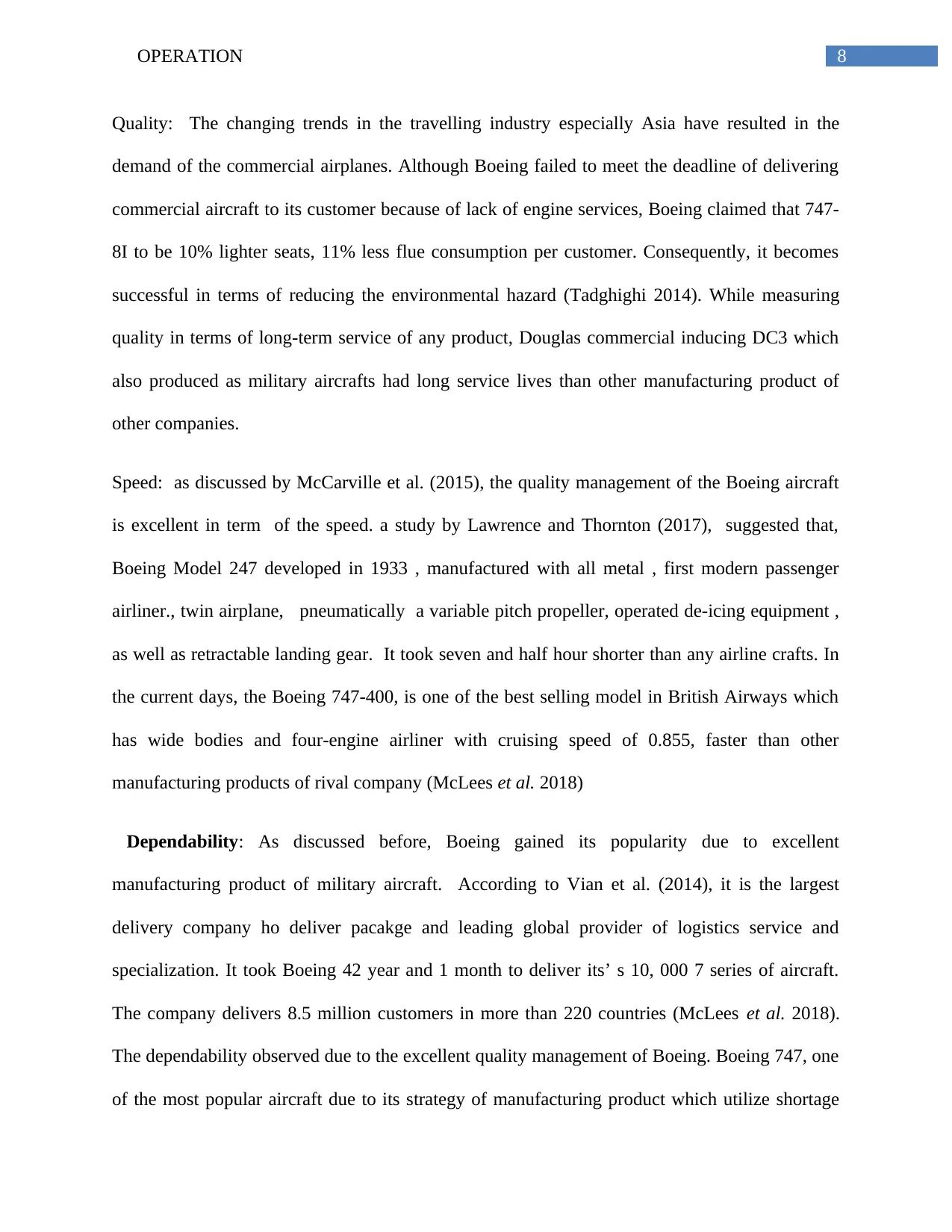
8OPERATION
Quality: The changing trends in the travelling industry especially Asia have resulted in the
demand of the commercial airplanes. Although Boeing failed to meet the deadline of delivering
commercial aircraft to its customer because of lack of engine services, Boeing claimed that 747-
8I to be 10% lighter seats, 11% less flue consumption per customer. Consequently, it becomes
successful in terms of reducing the environmental hazard (Tadghighi 2014). While measuring
quality in terms of long-term service of any product, Douglas commercial inducing DC3 which
also produced as military aircrafts had long service lives than other manufacturing product of
other companies.
Speed: as discussed by McCarville et al. (2015), the quality management of the Boeing aircraft
is excellent in term of the speed. a study by Lawrence and Thornton (2017), suggested that,
Boeing Model 247 developed in 1933 , manufactured with all metal , first modern passenger
airliner., twin airplane, pneumatically a variable pitch propeller, operated de-icing equipment ,
as well as retractable landing gear. It took seven and half hour shorter than any airline crafts. In
the current days, the Boeing 747-400, is one of the best selling model in British Airways which
has wide bodies and four-engine airliner with cruising speed of 0.855, faster than other
manufacturing products of rival company (McLees et al. 2018)
Dependability: As discussed before, Boeing gained its popularity due to excellent
manufacturing product of military aircraft. According to Vian et al. (2014), it is the largest
delivery company ho deliver pacakge and leading global provider of logistics service and
specialization. It took Boeing 42 year and 1 month to deliver its’ s 10, 000 7 series of aircraft.
The company delivers 8.5 million customers in more than 220 countries (McLees et al. 2018).
The dependability observed due to the excellent quality management of Boeing. Boeing 747, one
of the most popular aircraft due to its strategy of manufacturing product which utilize shortage
Quality: The changing trends in the travelling industry especially Asia have resulted in the
demand of the commercial airplanes. Although Boeing failed to meet the deadline of delivering
commercial aircraft to its customer because of lack of engine services, Boeing claimed that 747-
8I to be 10% lighter seats, 11% less flue consumption per customer. Consequently, it becomes
successful in terms of reducing the environmental hazard (Tadghighi 2014). While measuring
quality in terms of long-term service of any product, Douglas commercial inducing DC3 which
also produced as military aircrafts had long service lives than other manufacturing product of
other companies.
Speed: as discussed by McCarville et al. (2015), the quality management of the Boeing aircraft
is excellent in term of the speed. a study by Lawrence and Thornton (2017), suggested that,
Boeing Model 247 developed in 1933 , manufactured with all metal , first modern passenger
airliner., twin airplane, pneumatically a variable pitch propeller, operated de-icing equipment ,
as well as retractable landing gear. It took seven and half hour shorter than any airline crafts. In
the current days, the Boeing 747-400, is one of the best selling model in British Airways which
has wide bodies and four-engine airliner with cruising speed of 0.855, faster than other
manufacturing products of rival company (McLees et al. 2018)
Dependability: As discussed before, Boeing gained its popularity due to excellent
manufacturing product of military aircraft. According to Vian et al. (2014), it is the largest
delivery company ho deliver pacakge and leading global provider of logistics service and
specialization. It took Boeing 42 year and 1 month to deliver its’ s 10, 000 7 series of aircraft.
The company delivers 8.5 million customers in more than 220 countries (McLees et al. 2018).
The dependability observed due to the excellent quality management of Boeing. Boeing 747, one
of the most popular aircraft due to its strategy of manufacturing product which utilize shortage
⊘ This is a preview!⊘
Do you want full access?
Subscribe today to unlock all pages.

Trusted by 1+ million students worldwide
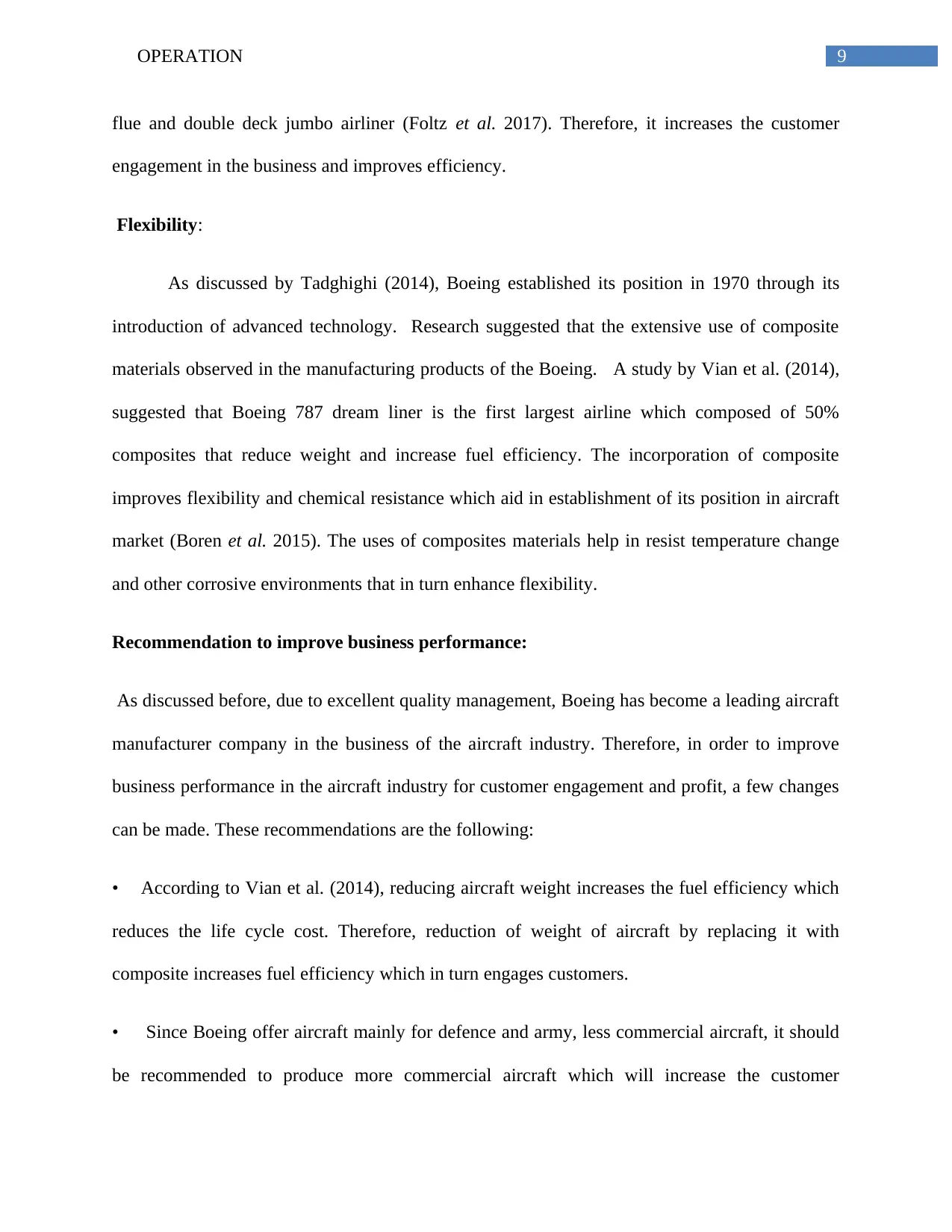
9OPERATION
flue and double deck jumbo airliner (Foltz et al. 2017). Therefore, it increases the customer
engagement in the business and improves efficiency.
Flexibility:
As discussed by Tadghighi (2014), Boeing established its position in 1970 through its
introduction of advanced technology. Research suggested that the extensive use of composite
materials observed in the manufacturing products of the Boeing. A study by Vian et al. (2014),
suggested that Boeing 787 dream liner is the first largest airline which composed of 50%
composites that reduce weight and increase fuel efficiency. The incorporation of composite
improves flexibility and chemical resistance which aid in establishment of its position in aircraft
market (Boren et al. 2015). The uses of composites materials help in resist temperature change
and other corrosive environments that in turn enhance flexibility.
Recommendation to improve business performance:
As discussed before, due to excellent quality management, Boeing has become a leading aircraft
manufacturer company in the business of the aircraft industry. Therefore, in order to improve
business performance in the aircraft industry for customer engagement and profit, a few changes
can be made. These recommendations are the following:
• According to Vian et al. (2014), reducing aircraft weight increases the fuel efficiency which
reduces the life cycle cost. Therefore, reduction of weight of aircraft by replacing it with
composite increases fuel efficiency which in turn engages customers.
• Since Boeing offer aircraft mainly for defence and army, less commercial aircraft, it should
be recommended to produce more commercial aircraft which will increase the customer
flue and double deck jumbo airliner (Foltz et al. 2017). Therefore, it increases the customer
engagement in the business and improves efficiency.
Flexibility:
As discussed by Tadghighi (2014), Boeing established its position in 1970 through its
introduction of advanced technology. Research suggested that the extensive use of composite
materials observed in the manufacturing products of the Boeing. A study by Vian et al. (2014),
suggested that Boeing 787 dream liner is the first largest airline which composed of 50%
composites that reduce weight and increase fuel efficiency. The incorporation of composite
improves flexibility and chemical resistance which aid in establishment of its position in aircraft
market (Boren et al. 2015). The uses of composites materials help in resist temperature change
and other corrosive environments that in turn enhance flexibility.
Recommendation to improve business performance:
As discussed before, due to excellent quality management, Boeing has become a leading aircraft
manufacturer company in the business of the aircraft industry. Therefore, in order to improve
business performance in the aircraft industry for customer engagement and profit, a few changes
can be made. These recommendations are the following:
• According to Vian et al. (2014), reducing aircraft weight increases the fuel efficiency which
reduces the life cycle cost. Therefore, reduction of weight of aircraft by replacing it with
composite increases fuel efficiency which in turn engages customers.
• Since Boeing offer aircraft mainly for defence and army, less commercial aircraft, it should
be recommended to produce more commercial aircraft which will increase the customer
Paraphrase This Document
Need a fresh take? Get an instant paraphrase of this document with our AI Paraphraser

10OPERATION
engagement, business performance and dependability of loyal consumers (Goetsch and Davis
2014).
engagement, business performance and dependability of loyal consumers (Goetsch and Davis
2014).
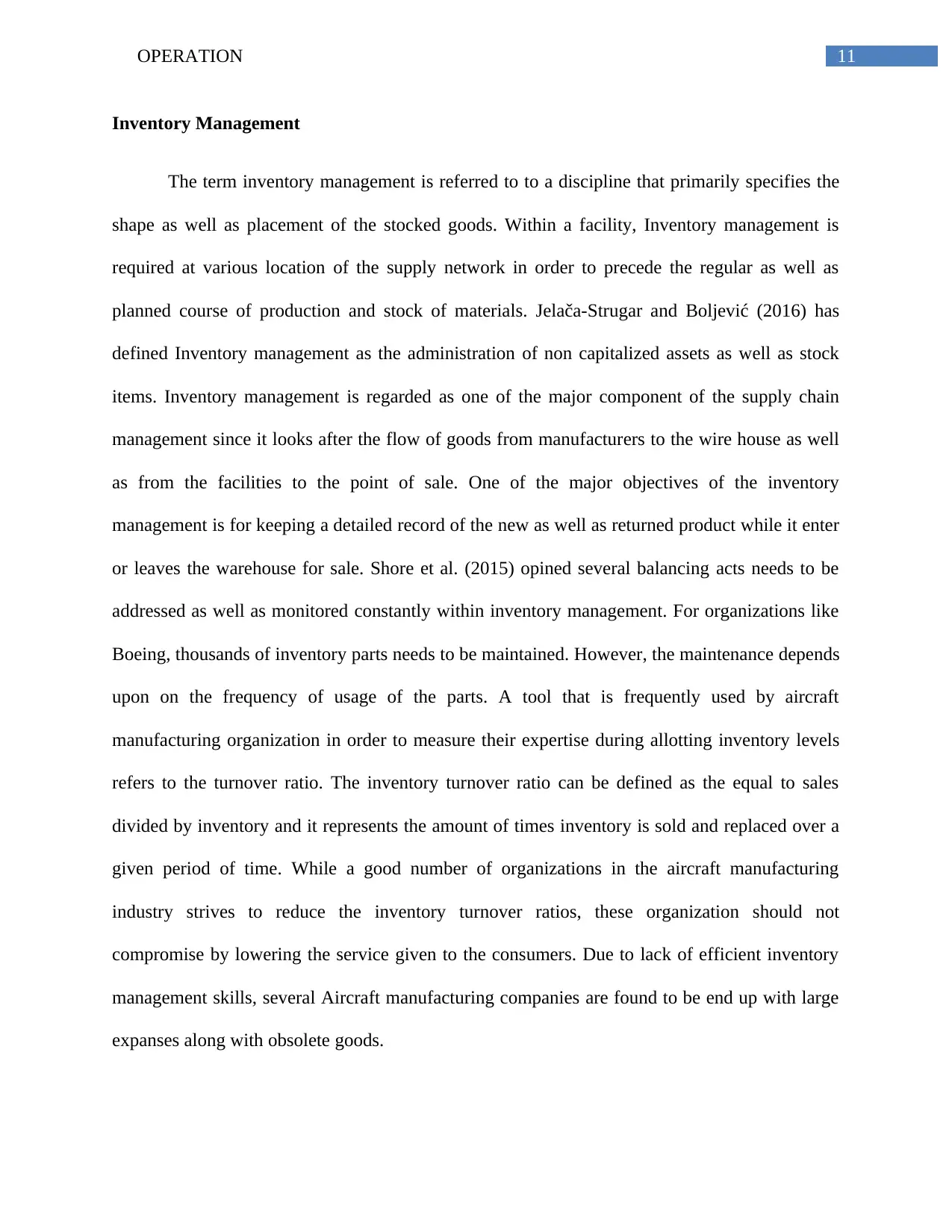
11OPERATION
Inventory Management
The term inventory management is referred to to a discipline that primarily specifies the
shape as well as placement of the stocked goods. Within a facility, Inventory management is
required at various location of the supply network in order to precede the regular as well as
planned course of production and stock of materials. Jelača-Strugar and Boljević (2016) has
defined Inventory management as the administration of non capitalized assets as well as stock
items. Inventory management is regarded as one of the major component of the supply chain
management since it looks after the flow of goods from manufacturers to the wire house as well
as from the facilities to the point of sale. One of the major objectives of the inventory
management is for keeping a detailed record of the new as well as returned product while it enter
or leaves the warehouse for sale. Shore et al. (2015) opined several balancing acts needs to be
addressed as well as monitored constantly within inventory management. For organizations like
Boeing, thousands of inventory parts needs to be maintained. However, the maintenance depends
upon on the frequency of usage of the parts. A tool that is frequently used by aircraft
manufacturing organization in order to measure their expertise during allotting inventory levels
refers to the turnover ratio. The inventory turnover ratio can be defined as the equal to sales
divided by inventory and it represents the amount of times inventory is sold and replaced over a
given period of time. While a good number of organizations in the aircraft manufacturing
industry strives to reduce the inventory turnover ratios, these organization should not
compromise by lowering the service given to the consumers. Due to lack of efficient inventory
management skills, several Aircraft manufacturing companies are found to be end up with large
expanses along with obsolete goods.
Inventory Management
The term inventory management is referred to to a discipline that primarily specifies the
shape as well as placement of the stocked goods. Within a facility, Inventory management is
required at various location of the supply network in order to precede the regular as well as
planned course of production and stock of materials. Jelača-Strugar and Boljević (2016) has
defined Inventory management as the administration of non capitalized assets as well as stock
items. Inventory management is regarded as one of the major component of the supply chain
management since it looks after the flow of goods from manufacturers to the wire house as well
as from the facilities to the point of sale. One of the major objectives of the inventory
management is for keeping a detailed record of the new as well as returned product while it enter
or leaves the warehouse for sale. Shore et al. (2015) opined several balancing acts needs to be
addressed as well as monitored constantly within inventory management. For organizations like
Boeing, thousands of inventory parts needs to be maintained. However, the maintenance depends
upon on the frequency of usage of the parts. A tool that is frequently used by aircraft
manufacturing organization in order to measure their expertise during allotting inventory levels
refers to the turnover ratio. The inventory turnover ratio can be defined as the equal to sales
divided by inventory and it represents the amount of times inventory is sold and replaced over a
given period of time. While a good number of organizations in the aircraft manufacturing
industry strives to reduce the inventory turnover ratios, these organization should not
compromise by lowering the service given to the consumers. Due to lack of efficient inventory
management skills, several Aircraft manufacturing companies are found to be end up with large
expanses along with obsolete goods.
⊘ This is a preview!⊘
Do you want full access?
Subscribe today to unlock all pages.

Trusted by 1+ million students worldwide
1 out of 27
Related Documents
Your All-in-One AI-Powered Toolkit for Academic Success.
+13062052269
info@desklib.com
Available 24*7 on WhatsApp / Email
![[object Object]](/_next/static/media/star-bottom.7253800d.svg)
Unlock your academic potential
Copyright © 2020–2025 A2Z Services. All Rights Reserved. Developed and managed by ZUCOL.





